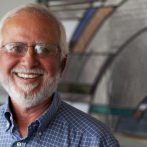 ME Professor A. Galip Ulsoy, William Clay Professor of Manufacturing, has been awarded a Distinguished University Professorship, one of the highest honors that the University can award its faculty.
ME Professor A. Galip Ulsoy, William Clay Professor of Manufacturing, has been awarded a Distinguished University Professorship, one of the highest honors that the University can award its faculty.
The Professorship, which carries annual salary and research supplements of $5000 respectively, honors full or associate professors for exceptional work in their fields, national or international renown, and superior teaching or mentorship. The position was created in 1947 is held until retirement. Ulsoy is the second ME professor to become a Distinguished Professor; Chia-Shun Yih was also honored in 1968. A formal awards dinner and ceremony will take place on Wednesday, October 7, 2009.
Ulsoy has taught at the University of Michigan since 1980, developing several new courses within the UM curriculum. He has held numerous service positions at the university, including the founding director of the Program in Manufacturing, the chair and associate chair of ME and the chair of the ME Graduate Program. He has also held several national service positions, including director of the National Science Foundation Division of Civil and Mechanical Systems from 2003-2005 and editor of the ASME Journal of Dynamic Systems, Measurement and Control. He is a member of the National Academy of Engineering, and the recipient of many other honors beyond the university, most recently the 2008 Society of Manufacturing Engineers Albert M. Sargent Progress Award, and the 2008 American Society of Mechanical Engineers Rufus T. Oldenburger Medal.
Ulsoy’s work on dynamic modeling, analysis, and control of mechanical systems has contributed significantly to manufacturing and automotive systems. He is one of the founders of the Engineering Center for Reconfigurable Manufacturing Systems at UM, and currently serves as its deputy director. Reconfigurable manufacturing systems are designed with adjustable production capacity and function to meet changes in the marketplace; the center brings new RMS technologies to factories, increasing their reliability and competitiveness. He is also the director of the Ground Robotics Research Center, launched in 2007 and sponsored by the U.S. Army. The center works to improve the reliability of the autonomous ground vehicles and mobile robots that the army uses to disable bombs or explore dangerous terrain. He is also working with Ford on designing modular controls for series hybrid vehicles, so that components on these vehicles can be altered or updated without necessitating a change to the system as a whole. Other current areas of research include time delay systems, binder force control in stamping and co-design.
Ulsoy’s work with on automotive dynamics and control, and his collaboration with Ford, provide him with insight into an industry that has particular importance for both Southeast Michigan and the University. Ulsoy is optimistic about the future of the industry in the U.S. and Michigan, predicting a “smaller but viable auto industry here.” Though he says that the companies have “made some mistakes in the past” he quickly notes that American car companies “have basically all the advanced technology that one could want—it’s just a matter of putting it into products at the right time when customers want that technology and doing it in a cost-effective way. Certainly, the opportunity is there for the auto industry to do very well in the future.”
Ulsoy’s long tenure at the University also provides a far-reaching view on a department that has seen many changes in the past 30 years. “For a long time our strength has been related to being close to auto industry and manufacturing industry. I think that’s probably still true, but certainly all throughout its history, Michigan has been much broader than that.” He notes recent work on MEMS and nanotechnology in the department, work that didn’t exist 20 or 30 years ago. In teaching, he’s seen “a lot of improvements” since his arrival, noting the design and laboratory courses at the sophomore, junior and senior level; the department’s excellent labotories; and its modernized curriculum.
